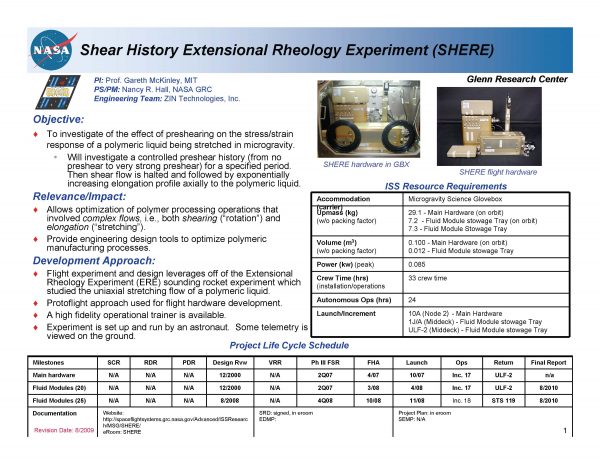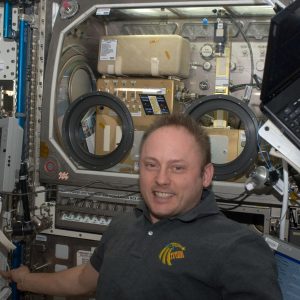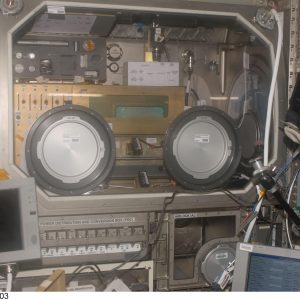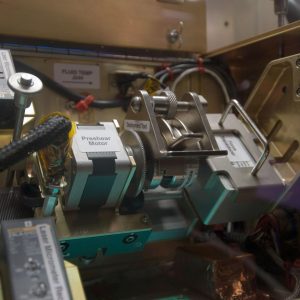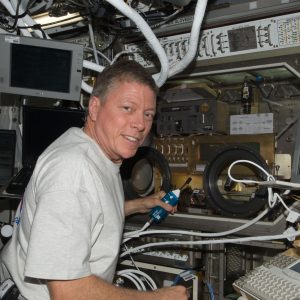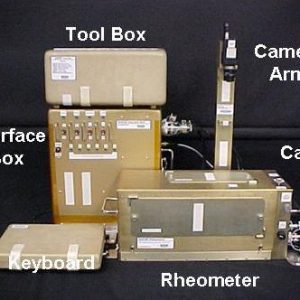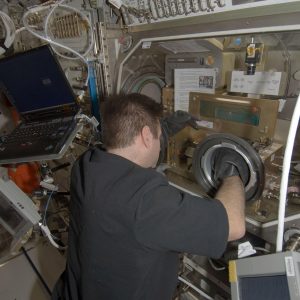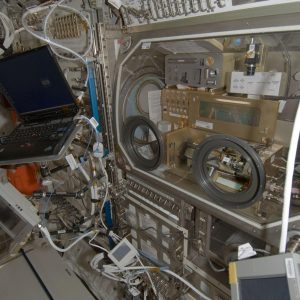SHERE
Shear History Extensional Rheology Experiment (SHERE)

The resistance of a fluid to an imposed flow is termed ‘viscosity’, and it is a fundamental material parameter by which manufacturers and end-users characterize a material. Normally, researchers place a material in a commercial instrument that imposes a simple rotational shearing flow and obtains a rate-dependent shear viscosity. While this level of characterization is sufficient for some processes, in typical industrial polymer processing operations the material experiences a complex flow history with both shear and extensional characteristics. For example, in fiber spinning, the fluid experiences a complex rotational shear flow as it flows through the spinneret head before entering a region of dominant axial elongation in the spinline.
Polymer behavior under these conditions is process-dependent and stems from their long chain structure. Polymers are typically hydrocarbon-based molecules composed of repeated molecular units and can contain hundreds to tens of thousands of these repeat units. The resulting long molecular chain is usually very flexible, allowing the polymer to coil, extend, and entangle with neighboring polymer chains. In its rest state, a typical polymer chain will assume a random coiled configuration. When exposed to a rotational shearing flow, this coil will align 45o to the flow direction and flip over and over again to coil the polymer chain. When exposed to an extensional flow, the coil extends axially and can be pulled taut if the flow is strong enough. Because polymers act like springs, more stress is required to stretch them to higher strains. This relationship between stress and extensional deformation rate (i.e., strain rate) is expressed as an extensional viscosity and is a fundamental material parameter independent of shear viscosity.
Science Overview
Due to the coiling effect of rotational shear flow on the polymer chains, shearing on the fluid immediately before extension will have an effect on the extensional behavior of the fluid. Therefore, the main objective of SHERE is to study the effect of rotational preshear on the extensional behavior of the fluid. Of specific interest is the transient evolution of the microstructure and viscoelastic tensile stresses that are present during the extension of the fluid.
The combination of both shearing and extensional flows is common in many polymer-processing operations such as extrusion, blow-molding and fiber spinning. Therefore, knowledge of the complete rheological properties of the polymer fluid is required in order to accurately predict and account for its flow behavior. In addition, if numerical simulations are to serve as a priori design tools for optimizing polymer processing operations, then it is critical to have an accurate knowledge of the extensional viscosity and its variation with temperature, concentration, molecular weight, and strain rate.
Unlike common Newtonian fluids, complex fluids such as polymers cannot be characterized by a single material parameter such as the Newtonian (shear) viscosity. Instead, they exhibit nonlinear responses to imposed deformations. The extensional function of non-Newtonian fluids is not constant but depends on both the rate of deformation and the total strain experienced by a fluid element.
A class of dilute polymer solutions, collectively referred to as ‘Boger fluids,’ has become a popular choice for rheological studies of non-Newtonian fluids and will be used in this experiment. These ideal elastic fluids exhibit a nearly constant shear viscosity, which allows a direct comparison of Boger fluids with Newtonian fluids having similar viscosities. The high viscosity of the suspending solvent results in long relaxation times and substantial normal stresses, and the low concentration of high molecular weight polymers facilitates modeling analysis.
Experiment Operations
SHERE is designed to fly in the Microgravity Science Glovebox (MSG) on the International Space Station (ISS). The main SHERE hardware consists of the interface box, rheometer, camera arm, cabling, keyboard, and tool box as shown in Figure 1. In addition, there are 25 fluid modules in a stowage tray (not shown). The interface box contains all power distribution, controllers, and data acquisition and storage. It also contains the video system that combines the camera view and data display onto one video signal for recording and downlink. The rheometer (see Figure 2) contains the rotational preshear motor, translation slider, sensitive force transducer, electroluminescent backlight panel, laser micrometer, and thermistors. During testing it will also contain one of the 25 fluid modules. The camera arm attaches to rheometer for video recording of the stretched fluid’s shape. The tool box contains miscellaneous tools used during setup and operation of the experiment. The keyboard is used to control the experiment with the help of the MSG video monitor. The 25 fluid modules contain the fluid that will be sheared and stretched during the course of the experiment. Each fluid module contains prepackaged Boger fluid, and all samples are identical.
The fluid modules are stored at 20ºC at least 24 hours prior to testing. After the hardware is installed in the MSG, the experiment goes through a set of initial check-out and calibration procedures. Once these procedures are complete, one fluid module is installed in the rheometer, the outside shells of the fluid module are removed and the inner shroud is slid back to expose the Boger fluid. The preshear motor is then rotated at a slow 100 rpm, and a stable fluid column is verified. Horizontal and vertical position controls are available as necessary to achieve a stable column. A test point is then selected (preshear and strain rates), and the experiment automatically executes. The fluid is presheared and stretched according to a preprogrammed exponential velocity profile. The stretch is stopped abruptly at 194 mm in length, and the fluid is allowed to relax. Each experiment lasts approximately five minutes, most of which is spent waiting for the fluid column to drain to the end plates and break in the middle. See Figure 2 – SHERE Rheometer
Afterwards, the translation slider is repositioned to the starting position, and the fluid column is recombined. If it is reusable due to criteria based on temperature, bubble contamination, and previous strain encountered, then another test can be performed with the same fluid module. Otherwise, it is removed, and the next one is installed for the next test.
Measurements
During each experiment, a smooth, bubble-free cylindrical liquid bridge is generated between two flat endplates. The liquid bridge will initially be 5 mm long and 10 mm in diameter. A rotational shear rate will be imposed on the fluid by rotating one endplate from 0 to 500 rpm for a predetermined time while holding the other endplate stationary. As soon as the rotation has stopped, an elongational deformation will be imposed by axially translating one of the endplates in an exponential manner in order to generate constant strain rates from 0.1 to 5.0 s-1. The tensile force and filament shape will be monitored during the elongation, and the elongation will stop at a length of approximately 194 mm. The position of the moving plate is recorded to verify the imposed velocity profile. By backlighting the test fluid with an electroluminescent panel and viewing the fluid column from above with a video camera, half of the fluid column’s shape can be recorded for use in later analyses and simulations. Additionally, the fluid diameter is recorded via a laser micrometer at the column’s midpoint. Fluid and air temperatures are digitally recorded from thermistors. Once the elongated bridge has been allowed to stabilize, the experiment will monitor subsequent evolution of the midpoint radius, filament shape, and tensile force in the column. Eventually, the filament necks down and breaks under the combined action of elastic and viscous capillary stresses. From measurements of force and radius during the stretch and relaxation of the fluid, we can compute the extensional viscosity as a function of strain rate and a function of the amount of preshearing.
Gallery
SHERE Contacts
Project Scientist/Project Manager: Nancy R. Hall, NASA Glenn Research Center
Principal Investigator: Prof. Gareth McKinley, MIT
Engineering Team: ZIN Technologies, Inc.

